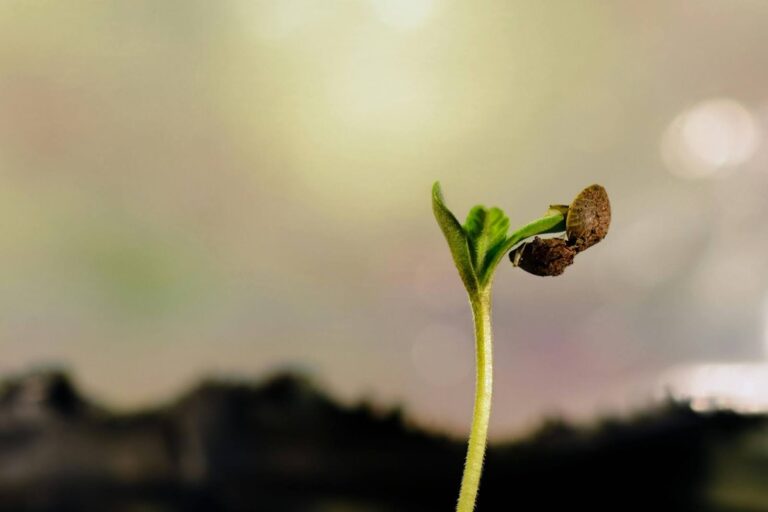Are you thinking about growing your cannabis but unsure where to start? You might be concerned about legal restrictions, the complexity of the process, or making costly mistakes. These concerns are common, especially among first-time growers.
Fortunately, cultivating cannabis is more straightforward than it seems. With the right knowledge, patience, and proper setup, you can successfully grow healthy plants and enjoy a rewarding experience. Whether you’re growing for personal use, medicinal purposes, commercial purpose, or simply as a hobby, understanding the fundamentals will set you up for success.
Cannabis cultivation blends science with hands-on practice. Learning about soil composition, water management, light exposure, and pest control is crucial to nurturing strong, resilient plants. Proper harvesting and curing techniques also play a significant role in achieving high-quality buds with optimal potency and flavor.
This guide will walk you through the essentials of cannabis growing, providing clear, step-by-step instructions to help you develop confidence in your skills. As you gain experience, you can refine your techniques, experiment with different strains, and ultimately cultivate premium-quality cannabis suited to your needs.
Setting Clear Goals for Your Cannabis Growth
Before you start, define what you want from your growth operation. Your goals will determine everything from strain selection to the type of setup you need. Consider the following:
- Personal vs. Commercial Cultivation: Are you growing cannabis for personal use, medical purposes, or to scale up into a business? Personal growers may focus on a few high-quality plants, while commercial operations require larger investments in equipment and compliance measures.
For example, If you’re growing for personal use, consider growing 4-5 plants. If you’re focusing on medicinal use, aim for higher CBD strains such as Charlotte’s Web.
- Desired Effects and Usage: If you are growing for recreational use, you might prioritize strains with high THC levels. For medicinal purposes, CBD-dominant strains may be more beneficial. Some growers also cultivate cannabis for extracts or edibles, which may influence strain choice.
- Growth Space and Setup: Consider your available space. Indoor growers should consider ventilation, lighting, and grow tents, while outdoor growers should plan for spacing between plants to ensure proper airflow.
- Time Commitment: Cannabis plants require regular care. Some strains need more maintenance than others, so choose one that matches the amount of time you can dedicate to monitoring water, nutrients, and pests.
- Harvest Expectations: Are you aiming for one large harvest per year, or would you prefer an autoflowering strain that allows multiple harvests annually? Understanding the growth cycle helps set realistic expectations.
Understanding Legal Regulations
Laws regarding cannabis cultivation vary by location, so research the regulations in your area before you plant. Some important factors to consider include:
- Plant Limits: Many regions restrict the number of plants you can grow at home, even for personal use.
- Licensing and Permits: If you plan to grow commercially, you may need special licenses or permits to comply with local and state laws.
- Zoning Restrictions: Some areas prohibit outdoor cannabis cultivation or require plants to be grown in enclosed spaces.
- Security Requirements: Some locations require growers to implement security measures, such as fencing, locked enclosures, or surveillance cameras, to prevent theft or unauthorized access.
- Transportation and Storage: Even if growing is legal, there may be regulations regarding how cannabis can be transported or stored after harvest.
- Environmental Compliance: Water usage, pesticide application, and waste disposal may be regulated to prevent environmental damage.
So, how do you choose the right cannabis strain to ensure healthy cannabis yield? Let us understand.
Selecting the Right Cannabis Strain
Choosing the right cannabis strain is one of your most important decisions. The strain affects everything from plant health to final yield, potency, and overall growth experience. Strains such as Northern Lights or Blue Dream are known for their ease of growth and resilience and are great for beginners. To find the best fit for your needs, consider the following factors:
- Climate Compatibility: If you are growing outdoors, select a strain that thrives in your region’s climate. Some cannabis plants flourish in warm, dry conditions, while others can handle cooler temperatures and higher humidity. Researching how different strains perform in your area will help prevent growth issues.
- Desired Effects: The effects of cannabis vary widely depending on the strain. Some strains are high in THC for strong psychoactive effects, while others contain more CBD for medicinal benefits.
- Yield and Growth Characteristics: Consider how much space you have and how much your plants want to grow. Some strains grow tall and require more maintenance, while others stay compact and are easier to manage. High-yielding strains produce more buds, making them a better choice if you want a larger harvest.
- Flowering Time: Strains vary in how long they take to reach maturity. Some flower in as little as 8 weeks, while others take 12 weeks or more. If you want a quicker harvest, auto-flowering strains may be a good option, as they do not rely on light cycles to start flowering.
- Pest and Disease Resistance: Some strains are naturally more resistant to pests, mold, and diseases. If you live in an area with high humidity or frequent rainfall, choose a strain that can handle those conditions without developing mold or mildew.
- Indica vs. Sativa vs. Hybrid: Indica strains are shorter and bushier and are known for their relaxing effects. Sativa strains grow taller, have longer flowering times, and produce more energetic effects. Hybrids combine traits from both types, balancing growth characteristics and effects.
Choosing the right strain sets the stage for smooth growth and a successful harvest. With PlanaCan, you can streamline the process by automating cultivation tasks using customizable templates. Outline each step from planting to harvest, then schedule tasks with a few clicks to keep your workflow consistent and efficient.
Now, let us understand how to prepare the location where you choose to grow your cannabis.
Preparing the Cannabis Growing Location
Choosing the right location is essential for healthy cannabis growth. Cannabis plants thrive in sunny environments, so select a spot with at least six hours of direct sunlight daily. The more light exposure your plants receive, the stronger and more productive they will be.
Consider the following factors when selecting your grow location:
- Sunlight Exposure: Ensure your plants receive full sunlight for most of the day. Choose a location with wind protection to prevent plant stress, if possible.
- Soil Quality: Test the soil for drainage and nutrient content if growing in the ground. Loose, well-aerated soil promotes root development and prevents waterlogging.
- Protection from Harsh Conditions: Strong winds, heavy rain, and extreme temperatures can impact plant growth. If your area experiences unpredictable weather, consider adding a windbreak or partial cover.
- Privacy and Security: Depending on local regulations, you may need to keep your growth hidden. Fencing or natural barriers like tall plants can help.
- Air Circulation: Proper airflow prevents mold and disease. Avoid cramped spaces where air cannot circulate freely around plants.
- Accessibility: Choose a location that allows easy access for watering, pruning, and monitoring plant health.
Ground vs. Pots: Which is Better?
Growing Method | Pros | Cons |
In-Ground | Natural nutrients, larger yields, less frequent watering | Harder to control pests, soil quality varies, and plants are fixed |
In Pots | Better soil control, easy to move, ideal for changing weather or privacy | Requires frequent watering, limited root space, potential for soil depletion |
So, how do you prepare the soil for the healthy growth of your cannabis plant? Let us find out.
Cannabis Soil Preparation and Amendments
Getting your soil right is one of the most important steps in growing healthy, high-yield cannabis plants. If you start with nutrient-rich, well-balanced soil, your plants will thrive with minimal intervention. Here’s how to prepare and amend your soil for the best results:
1. Choose the Right Base Soil
You need light, well-aerated soil with good drainage. A high-quality organic potting mix or a blend of peat moss, coco coir, and perlite works well. Avoid soils with synthetic fertilizers—natural is best.
2. Test and Adjust pH
Cannabis prefers slightly acidic soil, around 6.0–6.8 pH. Use a soil test kit to check your pH and adjust if needed:
- Too acidic: Add dolomite lime.
- Too alkaline: Use elemental sulfur or peat moss.
3. Boost Nutrients with Amendments
Your soil should have a balanced mix of macronutrients (NPK) and micronutrients (calcium, magnesium, sulfur, iron, etc.). Here’s what to add:
- Nitrogen (N) for growth: Worm castings, alfalfa meal, or compost
- Phosphorus (P) for root development: Bone meal or bat guano
- Potassium (K) for flowering: Kelp meal or wood ash
- Microbes for nutrient absorption: Mycorrhizae fungi and beneficial bacteria
4. Improve Drainage and Aeration
Cannabis roots need oxygen. To prevent compaction, mix in:
- Perlite or pumice (lightens soil, improves drainage)
- Coco coir or peat moss (retains moisture without becoming waterlogged)
5. Enhance Soil Health with Organic Practices
- Use Compost and Organic Matter: Compost adds slow-release nutrients and beneficial microbes. Mix in 10–20% high-quality compost like aged manure or homemade organic compost.
- Mulch for Moisture Retention: Add a layer of straw, shredded leaves, or wood chips to retain moisture, suppress weeds, regulate soil temperature, and slowly release nutrients.
- Consider Cover Crops: Growing clover, alfalfa, or other nitrogen-fixing plants between cycles helps replenish nutrients and improve soil structure.
6. Reusing and Recharging Soil
If you’re growing multiple cycles, you can reuse soil instead of replacing it by:
- Removing old root mass
- Re-amending with fresh compost and dry amendments
- Letting it rest for a few weeks before replanting
Tip: If you suspect pests or pathogens, you can sterilize used soil by baking it at 180–200°F (82–93°C) for 30 minutes or treating it with beneficial nematodes and compost teas.
7. DIY Super Soil for Minimal Feeding
Mix super soil with slow-release amendments like bat guano, rock dust, and biochar for self-sustaining growth. Let it sit for a month to reduce the need for bottled nutrients. However, this might not be applicable to every beginner and might be more suitable for experienced growers. PlanaCan provides a clear timeline for planning and tracking tasks, allowing you to schedule work in advance while managing daily activities. With a centralized calendar, you can make adjustments and ensure nothing is overlooked.
8. Organic Liquid Nutrient Teas
Boost your soil’s microbial life and nutrient availability with organic teas from compost, worm castings, or kelp. These teas feed beneficial microbes, improving soil health and plant resilience.
9. Let It ‘Cook’ Before Planting
If you’re using strong organic amendments, give your soil 2–4 weeks to break down nutrients. Keep it slightly moist and aerated during this period to activate microbial activity.
So, how do you plant cannabis seeds or seedlings? Let us find out.
Planting the Cannabis Seeds or Seedlings
Getting your cannabis plants off to a strong start is essential for a successful harvest. Proper planting techniques ensure healthy root development, resistance to stress, and vigorous growth. Here’s how to set your seeds or seedlings up for success:
Starting from Seeds
Starting from seeds allows you to control the entire growth process. However, proper germination and planting techniques are crucial to ensure strong, healthy seedlings.
- Germinate First: Soak your seeds in clean, pH-balanced water (6.0–6.5) for 12–24 hours. Then, place them between damp paper towels in a warm, dark spot (70–85°F) with 60–70% humidity. Check daily for taproots.
- Choose the Right Medium: Use light, well-draining soil or starter cubes designed for seedlings. Avoid heavy soils that can suffocate young roots.
- Plant with Care: Once the taproot is about ½ inch long, plant the seed ½ inch deep, root-side down. Cover lightly with soil and mist with water. Avoid direct sunlight at this stage.
- Provide Gentle Light: Place seedlings under low-intensity light (CFLs or LED grow lights) and maintain 60–70% humidity. If they start stretching (getting too tall or thin), they need stronger light or should be placed closer to the source.
Starting from Seedlings
Proper transplanting is essential if you’re starting with seedlings. This will minimize shock and encourage strong root development. Timing, handling, and environmental conditions ensure a smooth transition.
- Transplant at the Right Time: If your seedlings are in starter cubes or small pots, wait until they have at least two sets of true leaves before transplanting. Do not let roots become root-bound.
- Prepare the Soil: Use a well-aerated, nutrient-rich soil mix. Consider adding mycorrhizae to boost root health and nutrient absorption.
- Handle Gently: Always hold seedlings by the leaves, not the stem, to avoid damage. Place them carefully in the new container, making a hole slightly larger than the root ball.
- Gradual Light Exposure: If seedlings move from a weak light to a stronger grow light, introduce them gradually to prevent shock.
- Water Lightly: Give a gentle watering after transplanting. Avoid overwatering, which can cause root rot, and ensure good drainage.
A healthy start leads to stronger plants, faster growth, and bigger yields. Keep a close eye on temperature, humidity, and light to create the best conditions. PlanaCan eliminates the guesswork by helping you monitor soil conditions while tracking data from every harvest. With all insights in one place, you can refine your methods for higher yields and bigger profits.
Now, let us discuss how to create an effective cannabis watering schedule.
Creating an Efficient Cannabis Watering Schedule
Knowing how to water cannabis correctly is key to healthy growth. Too much water causes root rot, while too little leads to dehydration and stunted plants. Proper watering techniques promote strong roots, nutrient uptake, and plant vigor. Here is how to get it right:
1. Understand Your Plants’ Needs
Your cannabis plants have different water requirements at each stage:
- Seedlings: Keep the soil moist but not soggy. Use a spray bottle for gentle watering.
- Vegetative Stage: Plants need more water as they grow. Water deeply, but let the top inch of soil dry out before the next round.
- Flowering Stage: Reduce humidity and avoid overwatering to prevent mold. Keep a steady but slightly drier schedule.
2. Know Your Medium
- Soil: Water when the top 1-2 inches are dry.
- Coco Coir: Water more frequently since it dries fast.
- Hydroponics: Ensure a consistent nutrient-rich water flow.
3. Find the Right Frequency
Instead of sticking to a rigid daily schedule, check for signs your plants are thirsty:
- Wilting or drooping leaves
- Dry, lightweight pots
- Slightly dry soil (not bone dry)
A general rule: Water every 2-3 days in soil, but always check first.
4. Water the Right Way
- Use pH-balanced water (5.8-6.5 for soil, 5.5-6.0 for hydro).
- Water evenly until you get 10-20% runoff.
- Avoid watering leaves to prevent mold and pests.
5. Automate for Efficiency
Hand-watering works, but automation saves time and prevents mistakes. Consider:
- Drip irrigation for consistent moisture
- Timers to regulate the frequency
- Moisture sensors to avoid overwatering
6. Adjust for Environment
Heat, humidity, and airflow all affect how fast your soil dries. During hot, dry periods, you may need to water more often. In cooler, humid conditions, cut back to avoid root rot.
A smart watering schedule isn’t just about a timer; it’s about responding to your plants’ needs. Stay flexible, monitor your growth, and adjust as needed. PlanaCan provides a visual timeline for planning and tracking tasks, allowing you to map work ahead while managing daily activities. With real-time adjustments, nothing gets overlooked, keeping your growth on track.
Now, let us discuss how to ensure proper pest control and maintenance for your cannabis plant.
Natural Pest Control and Maintenance For Cannabis
Keeping pests under control is essential for healthy cannabis plants, but chemical pesticides can harm the environment and beneficial insects. Instead, focus on preventative care and natural solutions to maintain plant health.
A combination of beneficial insects, organic deterrents, and strategic planting can keep pest populations in check. Regular monitoring and proactive management help prevent infestations before they become serious problems. Below are effective natural methods to protect your crop:
1. Beneficial Insects
- Ladybugs and Praying Mantises: These predators feed on harmful pests like aphids and caterpillars.
- Lacewings and Parasitic Wasps: Effective in controlling mites and whiteflies without harming plants.
- Hoverflies: Their larvae consume aphids, thrips, and other soft-bodied pests.
- Predatory Nematodes: Microscopic worms that target soil-dwelling pests like fungus gnats and root aphids.
2. Organic Pest Control Solutions
- Neem Oil: A natural pesticide that repels pests while being safe for plants.
- Diatomaceous Earth: Sprinkling this fine powder around plants helps deter crawling insects.
- Soap and Water Spray: A simple homemade solution that eliminates soft-bodied pests like spider mites.
- Companion Planting: Growing plants like basil, marigolds, and garlic alongside cannabis can naturally repel pests and improve soil health.
- Physical Barriers: Netting and row covers prevent insects from reaching plants without affecting growth.
3. Companion Planting
Planting certain herbs and flowers near cannabis can naturally repel pests:
- Basil and Mint: Deters aphids, mosquitoes, and whiteflies.
- Marigolds: Prevents nematodes and repels beetles.
- Garlic and Chives: Discourages mites and fungal infections.
- Lavender: Repels moths, fleas, and ticks while attracting pollinators.
- Rosemary and Thyme: Helps deter caterpillars and spider mites.
- Sunflowers: They act as trap crops, drawing aphids away from cannabis plants.
4. Crop Rotation and Soil Health
- Rotate Crops Annually: Avoid planting cannabis in the same spot each season to disrupt pest life cycles and reduce soil depletion.
- Use Cover Crops: Plants like clover and alfalfa improve soil health by fixing nitrogen, deterring pests, and preventing erosion.
- Mulching: Retains moisture, suppresses weeds, regulates soil temperature, and prevents soil-borne pests from spreading.
- Compost and Organic Matter: Adding compost or organic fertilizers replenishes nutrients and enhances microbial activity.
- Soil Aeration: Loosening compacted soil improves drainage and root health, reducing disease risk.
- pH Monitoring: Regularly check soil pH to maintain optimal conditions for cannabis growth. PlanaCan eliminates the guesswork by tracking soil data and capturing insights from every harvest. You can refine your methods for higher yields and bigger profits with all your information in one place.
Conclusion
Growing cannabis outdoors has many advantages, from lower costs to larger yields. You can create a healthy and productive growth operation by following the right steps. If this is your first time, do not worry about perfection. Each growth cycle is a chance to learn and improve. With the right approach, you will be harvesting top-quality cannabis in no time.
PlanaCan provides essential tools to maximize yields and efficiently manage crops, smoothing the process. Using customizable templates, you can define and streamline cultivation processes. Every step, from planting to harvest, is organized into a clear and structured workflow, helping you reduce errors and maintain consistency.
You also get access to a visual timeline for planning and tracking tasks, ensuring you stay on schedule while making real-time adjustments. It centralizes all necessary information so everyone knows what needs to be done and when to prevent missed tasks and improve overall efficiency.
With PlanaCan, you can reduce manual effort, enhance organization, and focus on growing high-quality cannabis. Whether you are a beginner or an experienced cultivator, PlanaCan simplifies the growing process, making it more manageable and productive.
Schedule a free call today to learn how PlanaCan can help you optimize your growth operation and achieve better results with less effort.




